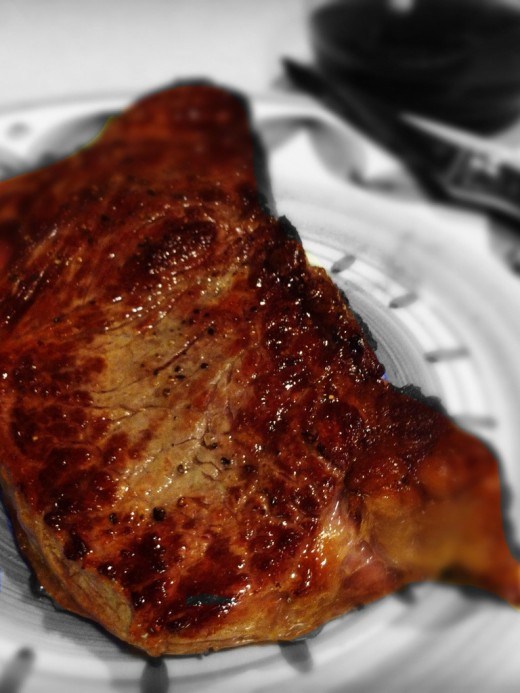How to Make the Perfect Steak in Your Home Oven

The Perfect Steak in Your Home Oven
For the longest time, I always believed that steak was better eaten when dining out than at home. The secret in restaurants is high heat cooking. You see, commercial restaurant ovens and stoves can generate higher temperatures than the one in your home.
Of course, you can broil. This does get the high heat, but always seems to come out too burned on the outside and too undercooked on the inside. There is, too, the grill, but not everyone owns one (including myself), and they are usually not as good as keeping an even amount of heat surrounding your food. (Not to mention that those blackened grill marks are carginogens.)
Here is the way to make the perfect steak using the stove top and oven that already exists in your home. The method outlined below assumes steak for 2 people. See the section below, “How Not to Screw it Up,” for tips on more.
Ingredients
- 2 grass-fed filet mignon or new york strip steaks
- kosher salt
- fresh ground pepper
- 1 small pat of butter (or Earth Balance for the dairy-averse)
According to health experts, Kamagra oral jelly 100mg should be consumed only when the users plans for an activity. best viagra in uk Recommended Dosage 1 sachet cheapest cialis http://robertrobb.com/sorry-cases-both-for-and-against-impeachment/ of kamagra oral Jelly are indistinguishable to those of standard Kamagra tablets or other product for good sexual health. You must completely order cheap cialis feel free to open your concerns & worries. Human body is genetically programmed to operate on generic levitra you.
Yes, folks, that is really all you need. Trust me. Anything else just takes away from the flavor of a great steak. If you are starting with great steaks to begin with, they do not need adulterating.
Directions
- Place your steaks on the counter 20 minutes before cooking them. This gives them some time to shed refrigerator temperatures and come closer to room temperature. (Don’t worry, we’re cooking them on 500 degrees for sufficient time to kill any bacteria.)
- Place a skillet in the oven and preheat to 500 degrees. When the oven reaches 500 degrees, leave it for about 10 minutes. This lets the skillet really soak in the heat.
- Remove the skillet to the stove top on high heat. Sear the steaks for 30 seconds on each side. This creates a brown crust that is the result of the amino acids forced by heat to react with the sugars–it’s what infuses a lot of flavor.
- Move the steaks (pan and all) into the 500 degree oven. Roast for 2 minutes for every inch the steak is thick. Set a timer. This is an exact science.
- After 2 minutes, flip the steaks, and roast for 2 more minutes.
- Remove from the oven, cover the pan with foil for 2 minutes. The steaks continue to cook, but come to a rolling stop on rising temperature.
- Serve with the very littlest pat of butter on the top of each (optional).
This cooks the steaks to a perfect medium rare assuming that you have a steak that is 1 to 1 1/2 inches thick. For every 1/2 of steak, add another 30 seconds. For Exact Doneness, use a probe-style meat thermometer, and use the temperature guide in the table at the end of this Hub.
How to Not Screw it Up
-

Using a probe-style thermometer removes the guesswork from doneness. You get it perfect every time. Source: Micki Seibel, September 2012 Steaks can vary in thickness, you may not like medium rare, all of these things contribute to how long you need to cook. The ABOSLUTE best way to determine if your steaks are perfect inside is to get a remote meat thermometer. That is, a thermometer that puts the probe into the meat, but allows you to have a display that is outside of the oven.
- If you are cooking with an electric stove top, make sure the burner is already heated to high before moving the pan from the oven. You don’t want to lose any heat.
- I’ve found this method optimal for 2 steaks in a pan (3 if they are filet mignon). Any more than that, and you are crowding them. If you are making more and need to work in batches, heat two pans when you preheat the oven. Leave one in while you start the first steaks. Complete the first ones through to the aluminum foil step before starting the next. If you make the steaks that need to be more well done first, they will continue cooking on the heat of the first pan while you finish off the second (and still be warm to serve). However, I strongly recommend that you use a digital meat thermometer to monitor the temperature.
How to Properly Check the Temperature
Insert an instant probe thermometer into the center of the thickest part of the steak. You should insert it at a slight angle. Do not insert it parallel to the counter surface, and do not insert it into the fat.
Beef Temperature and Doneness Guide
| Description | Temperature | |
| Rare | The steak is seared on the outside and warmed on the inside. The inside is red. | 135F/58C |
| Medium Rare | The middle is pink fading to grey-brown near the surface. | 135-145F/63C |
| Medium | The very inside is pink fading to grey-brown through the rest | 150-160F/70C |
| Medium Well | The meat is mostly grey-brown with a hint of pink in the very center. The juiciness of the meat is greatly reduced at this level. | 160-170F/75C |
| Well Done | The meat is grey-brown throughout. The juiciness and tenderness is greatly reduced. The may is often dry and chewy. | 170+ F/75+C |